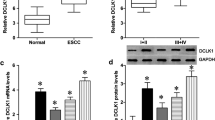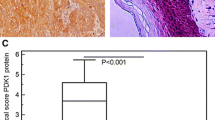Abstract
Dickkopf-1 (DKK1) is an inhibitor of Wnt/β-catenin signaling pathway. High levels of DKK1 protein were found in a series of cancers. However, the role of DKK1 in the progression of esophageal carcinoma is not fully understood. In the present study, RT-PCR and Western blot were used to detect the expression of DKK1 in esophageal carcinoma tissues, matched adjacent normal esophageal tissues, and esophageal carcinoma cell lines. Our results showed that the expression of DKK1 was upregulated on both mRNA and protein levels in esophageal carcinoma tissues compared with the adjacent normal esophageal tissues, meanwhile, in four esophageal carcinoma cell lines analyzed, expression of DKK1 was detected with different levels. Immunohistochemistry and immunofluoresence revealed that the distribution of DKK1 was mainly in the cytoplasm in both carcinoma tissues and cell lines. To further explore the biological effects of DKK1 on proliferation, cell cycle and invasion capability, we constructed the eukaryotic expression vector pCMV-Tab-2b-DKK1 which can effectively overexpress DKK1. Subsequently, we observed that exogenous expression of DKK1 in EC9706 cell line resulted in an increased rate of proliferation, and S stage and G2/M stage ratio whereas G0/G1 ratio was decreased. In order to evaluate the invasion capability Boyden chamber was analyzed which implied that overexpression of DKK1 resulted in an increase in the invasion ability in EC9706 cell line. Taken together, the study indicates that DKK1 might be a key regulator in the progression of esophageal carcinoma and a potential therapeutic target in esophageal carcinoma.




Similar content being viewed by others
References
Cadigan KM, Liu YI (2006) Wnt signaling: complexity at the surface. J Cell Sci 119(Pt 3):395–402
Darlavoix T et al (2009) Altered expression of CD44 and DKK1 in the progression of Barrett’s esophagus to esophageal adenocarcinoma. Virchows Arch 454(6):629–637
Forget MA et al (2007) The Wnt pathway regulator DKK1 is preferentially expressed in hormone-resistant breast tumours and in some common cancer types. Br J Cancer 96(4):646–653
Fulciniti M et al (2009) Anti-DKK1 mAb (BHQ880) as a potential therapeutic agent for multiple myeloma. Blood 114(2):371–379
Gonzalez-Sancho JM et al (2005) The Wnt antagonist DICKKOPF-1 gene is a downstream target of beta-catenin/TCF and is downregulated in human colon cancer. Oncogene 24(6):1098–1103
Gregory CA et al (2003) The Wnt signaling inhibitor Dickkopf-1 is required for reentry into the cell cycle of human adult stem cells from bone marrow. J Biol Chem 278(30):28067–28078
Klaus A, Birchmeier W (2008) Wnt signalling and its impact on development and cancer. Nat Rev Cancer 8(5):387–398
Kuhl M (2002) Non-canonical Wnt signaling in Xenopus: regulation of axis formation and gastrulation. Semin Cell Dev Biol 13(3):243–249
Kuhl M et al (2000) The Wnt/Ca2+ pathway: a new vertebrate Wnt signaling pathway takes shape. Trends Genet 16(7):279–283
Makino T et al (2009) Dickkopf-1 expression as a marker for predicting clinical outcome in esophageal squamous cell carcinoma. Ann Surg Oncol 16(7):2058–2064
Mao B et al (2002) Kremen proteins are Dickkopf receptors that regulate Wnt/beta-catenin signalling. Nature 417(6889):664–667
Mikheev AM et al (2004) A functional genomics approach for the identification of putative tumor suppressor genes: Dickkopf-1 as suppressor of HeLa cell transformation. Carcinogenesis 25(1):47–59
Niehrs C (2006) Function and biological roles of the Dickkopf family of Wnt modulators. Oncogene 25(57):7469–7481
Niida A et al (2004) DKK1, a negative regulator of Wnt signaling, is a target of the beta-catenin/TCF pathway. Oncogene 23(52):8520–8526
Patil MA et al (2005) An integrated data analysis approach to characterize genes highly expressed in hepatocellular carcinoma. Oncogene 24(23):3737–3747
Semenov MV et al (2001) Head inducer Dickkopf-1 is a ligand for Wnt coreceptor LRP6. Curr Biol 11(12):951–961
Sheng SL et al (2009) Clinical significance and prognostic value of serum Dickkopf-1 concentrations in patients with lung cancer. Clin Chem 55(9):1656–1664
Shimada H et al (2003) Prediction of survival with squamous cell carcinoma antigen in patients with resectable esophageal squamous cell carcinoma. Surgery 133(5):486–494
Takahashi N et al (2010) Dickkopf-1 is overexpressed in human pancreatic ductal adenocarcinoma cells and is involved in invasive growth. Int J Cancer 126(7):1611–1620
Tamoto E et al (2004) Gene-expression profile changes correlated with tumor progression and lymph node metastasis in esophageal cancer. Clin Cancer Res 10(11):3629–3638
Wirths O et al (2003) Overexpression of human Dickkopf-1, an antagonist of wingless/WNT signaling, in human hepatoblastomas and Wilms’ tumors. Lab Invest 83(3):429–434
Yamabuki T et al (2007) Dikkopf-1 as a novel serologic and prognostic biomarker for lung and esophageal carcinomas. Cancer Res 67(6):2517–2525
Yap JC et al (2010) Intensity modulated radiation therapy in the treatment of esophageal cancer. Thorac Cancer 1(2):62–69
You L et al (2004) Inhibition of Wnt-1 signaling induces apoptosis in beta-catenin-deficient mesothelioma cells. Cancer Res 64(10):3474–3478
Yu B et al (2009) Elevated expression of DKK1 is associated with cytoplasmic/nuclear beta-catenin accumulation and poor prognosis in hepatocellular carcinomas. J Hepatol 50(5):948–957
Zhu Y et al (2009) Human mesenchymal stem cells inhibit cancer cell proliferation by secreting DKK-1. Leukemia 23(5):925–933
Acknowledgments
This work was supported by grants from the Key Project of National Natural Science Foundation of China (30430300), “863”(2006AA02A401), “973”(2010CB529405), Major Project of Tianjin Sci-Tech Support Program (07SYSYSF05000), and Key Project of Tianjin Sci-Tech Support Program (06YFSZSF05300) to Qinghua Zhou.
Author information
Authors and Affiliations
Corresponding authors
Additional information
S. Li and X. Qin have equally contributed.
Rights and permissions
About this article
Cite this article
Li, S., Qin, X., Liu, B. et al. Dickkopf-1 is involved in invasive growth of esophageal cancer cells. J Mol Hist 42, 491–498 (2011). https://doi.org/10.1007/s10735-011-9347-1
Received:
Accepted:
Published:
Issue Date:
DOI: https://doi.org/10.1007/s10735-011-9347-1




